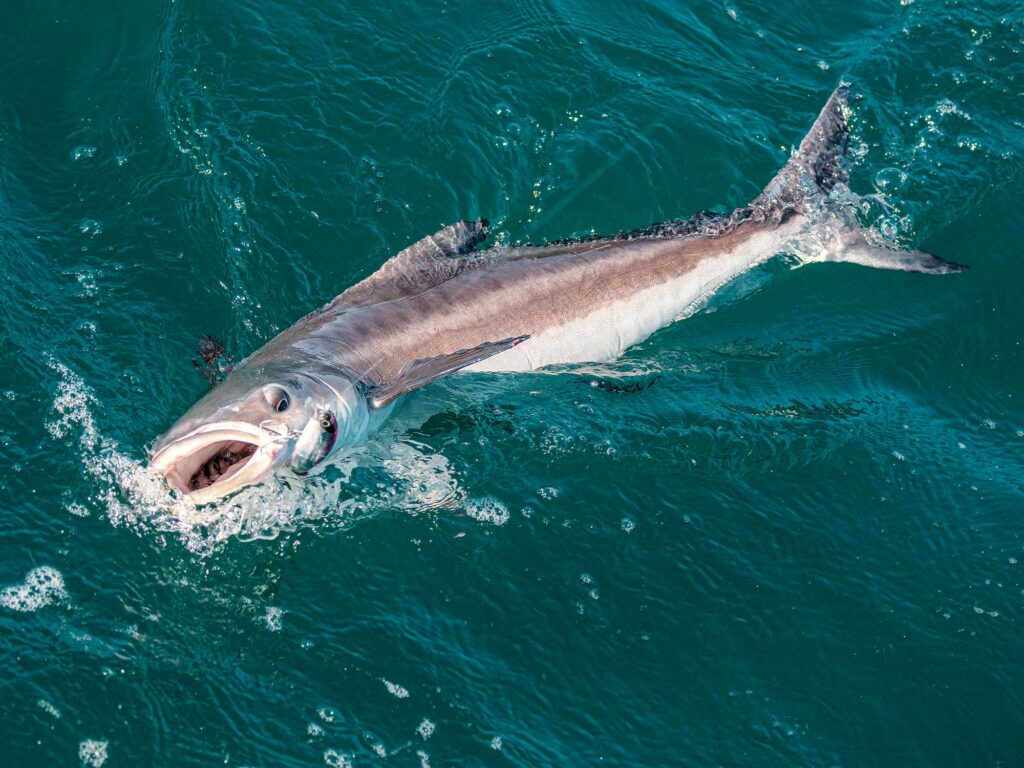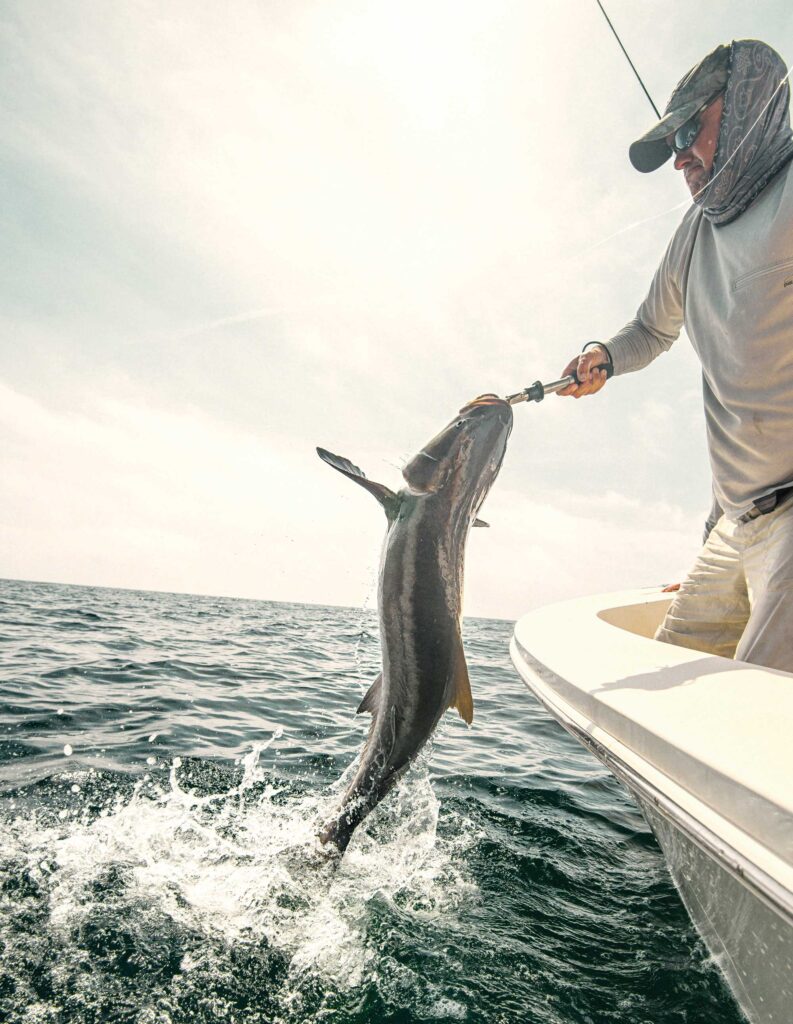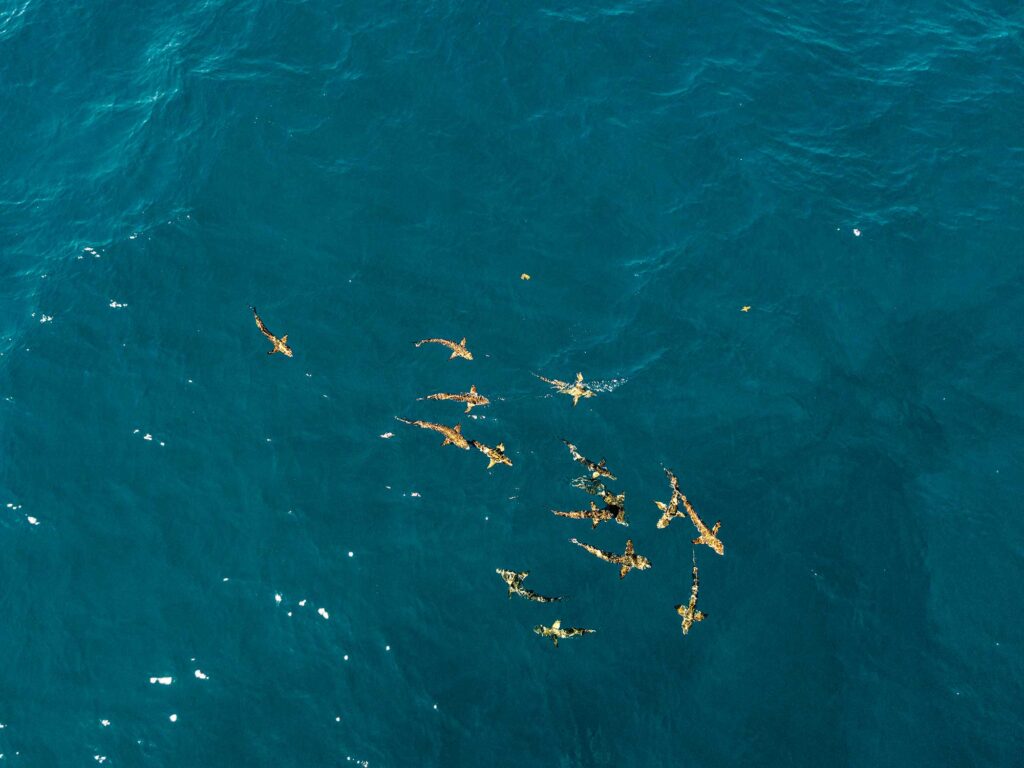
Perched high in the tower of Capt. Zack Hoffman’s Clock Work, we scoured large swaths of Chesapeake Bay in search of cruising cobia. Without such height, it’s challenging at best to distinguish the brown silhouettes migrating through these dusty-green waters. I know firsthand of the struggles, as Hoffman and I did this aboard my boat several years back—Hoffman spent most of the day standing on my T-top (no tower) for whatever sight advantage he could muster, however slight.
This time, given the elevation on Hoffman’s charter boat, nothing escaped us. We limited out on cobia and released others. Once a single cobia or pair were spotted, the boat was positioned to where an angler in the tower could cast a live bait or lure mere inches in front of the cruising fish. Upon hooking up, and usually after the initial run, the angler needed to get down into the cockpit for the full fight. No doubt, there are a lot of moving pieces to this game.
Enjoy the Sights
Based out of Seaford, Virginia, Hoffman is among the best at sight-fishing for cobia. And while sight-fishing for cobia is practiced commonly in other regions—such as off the Florida Panhandle and Alabama coasts, near towers and shrimp boats in the Gulf, and along the coast and near wrecks off southern Florida—nowhere has the tactic been as consistent in recent years than Chesapeake Bay.
“From about Memorial Day to the end of September, we see large numbers of cobia in Chesapeake Bay,” Hoffman says. “I believe these are spawning aggregations. On a clear, sunny day and with little wind, sight-fishing is very productive. Chumming for cobia is also popular, but sight-fishing enables much more ground to be covered.”
From high in his tower, Hoffman slowly cruises and scans the water for cobia. He seeks out contour lines, channel edges, bait pods, rays, buoys, pilings and bridges. A quality sonar is vitally important for this style of fishing.

The Perfect Pitch
Our tackle consisted of Penn 5000-size spinners spooled with 30-pound-test Sufix 832 braid. Our leaders were 8-pound fluorocarbon, tied to a 7/0 or 8/0 VMC live-bait hook with an overhand loop knot. I had my best luck with 2 feet of leader; short leaders enable long, unobstructed casts because the connection doesn’t pass through rod guides. Furthermore, knot wear from guide friction is also eliminated. Anglers often prefer heavier braid, like 50-pound-test. However, the heavier the braid, the shorter the casting distances, so weigh your options carefully.
A variety of baits, live and artificial, are paramount for success. “Live eels, croakers and spot are good cobia baits,” Hoffman claims. “Some days they’ll turn off one bait but devour another. Variety is important to counter changes in feeding aggression.”
I vividly recall sight-fishing for cobia out of Orange Beach, Alabama, with Capt. Ben Fairey. We had stalked one cobia for nearly 2 miles and pitched it a live pinfish, mullet, blue crab, blue runner and eel. Our last bait choice was a lowly saltwater catfish, which I cast out. The cobia lit up and inhaled the bait. After a spirited battle on 20-pound spin tackle, the 57-pound fish was in the boat.
Read Next: Cobia Fishing in the Florida Keys
Eel Imposters
Catching a cobia on an artificial deserves extra bragging rights. Eels are a key cobia forage, and their soft-plastic imitators are top producers. But if a cobia isn’t responding, a simple change in the artificial eel’s length or color could turn the tables. Keep a variety of eels in various lengths and colors rigged and ready to cast.
One of the all-time best cobia lures was conceived in the Florida Keys primarily for barracuda: the tube lure. It’s basically a length of surgical tubing with a small egg sinker inserted in one end and single-strand wire leader running the length of the lure. The wire passes through the tube and egg sinker, ending at a barrel swivel where you tie your line. Its tubing can have a single hook, treble hook or pair of trebles. The lure was originally intended to mimic a fast-moving houndfish, a top prey of barracuda. Cobia easily interpret one as an eel, especially when retrieved slowly and jigged.
For longer casting distances and action, topwater chuggers are excellent for cruising cobia. Should a cobia give pursuit, pick up speed as it stalks the plug. The objective is to make it think the bait is getting away. An ensuing strike is often powerful, so be ready with solid hook-sets.
Plain jigs and those tipped with plastic shads and eels are also deadly pitch baits. Additionally, these offerings can be bounced along bottom for deep-holding cobia, particularly around wrecks, buoys and bridge pilings.
On my trip with Hoffman, backup rods stood ready for followers. On more than one occasion, a second cobia appeared behind a hooked one. Make a well-placed cast just behind the hooked fish; avoiding crossing or interfering with the main line. Jigs work well in this situation. Act quickly because the opportunity to score a follower could soon evaporate.

Unusual Options
While searching for cobia, I pondered how trolling a pair of deep-diving swimming plugs would fare. They’d certainly swim well, cover a lot of ground and, perhaps, result in cobia finding us.
Also, especially when drifting along contour lines or while anchored and chumming, I thought about how a fishing kite with two or three baits splashing at the surface would produce. I’ve caught cobia before on kite baits intended for sailfish off South Florida, so why wouldn’t the tactic work here?
“I did it a few times here,” Hoffman told me. “I liked it and believe it will work. I need to put more time into it. I’m sure if more people try kite-fishing and catch cobia, you’ll soon see it catch on here.”
Not Finding Them? Try Chumming
On cloudy or breezy days, sight-fishing for cobia is a tough proposition. These are prime conditions to chum and soak bottom baits while anchored by channel edges, tight bottom contours, wrecks and other structures. While not as challenging as sight-fishing, chumming puts cobia in the boat.
“You can chum fish all year, though summer is pretty good in the Chesapeake,” Capt. Zack Hoffman says. “It’s pretty much anchoring, sending over a chum pot—I prefer a gallon bucket of frozen bunker, which I add menhaden oil to—and setting baits on bottom.”
A fish-finder rig made of 2 ½ feet of 60- to 80-pound fluorocarbon leader with a 7/0 or 8/0 hook and pyramid sinker is Hoffman’s basic terminal rig. In addition to live baits, cut fresh baits and even half a blue crab all produce. Remember, variety is often the key to success with cobia, even when chumming.
For best sport, use lines no heavier than 20-pound-test. Small and even midsize cobia can be fought from an anchored boat. However, for those big ones, keep the end of the anchor rode tied to a poly ball. Should a big fish require chasing, simply start the boat and toss over the anchor rode and ball. When done, motor back to the poly ball, recleat the rode and resume fishing. Another tip: Wrap electrical tape around the rode where it’s cleated off. This way, you can come tight right on the spot where you caught your last fish.
Plop, Plop, Fizz, Fizz
A trick you likely haven’t heard of to make a stubborn cobia eat was shown to me by my longtime Texas friend, Capt. Carl Christoph. He and I were far offshore Freeport, bird-dogging shrimp boats for cobia. We came upon a boat with two cobia frolicking at the surface behind it. The smaller one readily ate, but the big fish was disinterested in our baits, save for a quick glance once they hit the water.
Christoph swore me to secrecy at the time, and I agreed. He took a bottle of Alka-Seltzer from his tackle bag, made a small slit in the belly of a fresh menhaden, and crammed in two tablets. Upon hitting the water, the slow-sinking bait emitted bubbles much like an aerator. To my surprise, the fish devoured it. Christoph had his hands full with 12-pound baitcasting tackle, but he eventually bested a cobia that weighed 67 pounds. And by the way, the statute of limitations has long surpassed my promise to my friend.









